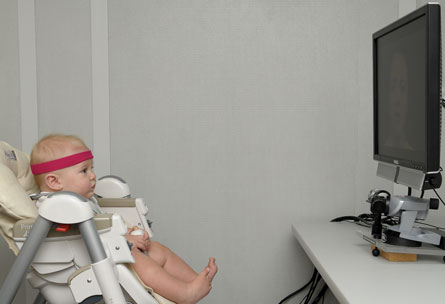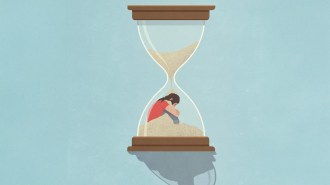Babies lip-read before talking
Babblers focus on adults’ mouths when learning how to speak
When adults mouth off, babies learn by watching. As infants start babbling at around age 6 months in preparation for talking, they shift from focusing on adults’ eyes to paying special attention to speakers’ mouths, a new study finds.

As tots become able to blurt out words and simple statements at age 1, they go back to concentrating on adults’ eyes, say psychologist David Lewkowicz and psychology graduate student Amy Hansen-Tift, both of Florida Atlantic University in Boca Raton. Whereas babbling babies match up what adults say with how they say it, budding talkers can afford to look for communication signals in a speakers’ eyes, the scientists propose in a paper published online January 17 in the Proceedings of the National Academy of Sciences.
“Babies start to lip-read when they learn to babble,” Lewkowicz says. “At that time, infants respond to what they see and hear as a unified stimulus.”
Researchers already knew that adults use senses other than sound to understand speech (Science News Online: 11/25/09). But investigators have typically assumed that babies learn to speak solely by listening to adults talk, Lewkowicz says. The new findings put lip-reading on a par with listening as a key element in learning to talk, and suggest that lip-reading past a child’s first birthday represents an early warning sign of communication disorders such as autism.
Lewkowicz and Hansen-Tift tested 179 infants from English-speaking families at age 4, 6, 8 or 12 months. Special devices tracked where babies looked when shown videos of women speaking English or a foreign language — in this case, Spanish.
From age 8 months to 1 year, babbling babies read the lips of both English and Spanish speakers, the researchers say. Nascent talkers shifted to looking mainly at the eyes of an English-speaker, but continued to home in on the mouth of a woman speaking the unfamiliar language of Spanish. Increasing familiarity with a native language narrows a youngster’s ability to perceive novel speech sounds, necessitating continued lip-reading of foreign-language speakers, the researchers say.
Lewkowicz and Hansen-Tift also report that on average, infants’ pupils increasingly dilated between ages 8 months and 1 year in response to Spanish speakers, a sign of surprise at encountering unfamiliar speech.
Infants who continue to read the lips of native-language speakers into the second year of life may stand an elevated chance of developing autism or other early communication disorders, Lewkowicz suggests. By 2 years of age, children with autism avoid eye contact and focus on speakers’ mouths (SN: 4/25/09, p. 8), but the new findings raise the possibility of identifying kids headed for this developmental disorder even earlier, he says.
“These results are novel and I would not have predicted them,” remarks psycholinguist D. Kimbrough Oller of the University of Memphis in Tennessee, a pioneer in studying how babies’ babbling leads to talking.
The new study indicates that “it is normal for infants to increasingly look away from adults’ eyes and at their mouths from six to 12 months of age,” comments psychologist and autism researcher Rhea Paul of the Yale Child Study Center. It hasn’t yet been demonstrated that children who continue to look at the mouths of native-language speakers after age 1 develop autism or other communication problems more frequently than those who shift to looking at speakers’ eyes, Paul cautions.







